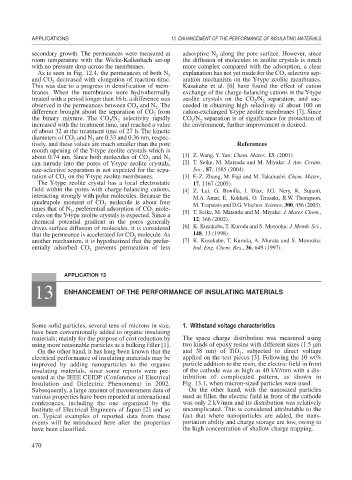Page 498 - Book Hosokawa Nanoparticle Technology Handbook
P. 498
APPLICATIONS 13 ENHANCEMENT OF THE PERFORMANCE OF INSULATING MATERIALS
secondary growth. The permeances were measured at adsorptive N along the pore surface. However, since
2
room temperature with the Wicke-Kallenbach set-up the diffusion of molecules in zeolite crystals is much
with no pressure drop across the membranes. more complex compared with the adsorption, a clear
As is seen in Fig. 12.4, the permeances of both N 2 explanation has not yet made for the CO selective sep-
2
and CO decreased with elongation of reaction time. aration mechanism on the Y-type zeolite membranes.
2
This was due to a progress in densification of mem- Kusakabe et al. [6] have found the effect of cation
branes. When the membranes were hydrothermally exchange of the charge-balancing cations in the Y-type
treated with a period longer than 16 h, a difference was zeolite crystals on the CO /N separation, and suc-
2
2
observed in the permeances between CO and N . The ceeded in obtaining high selectivity of about 100 on
2
2
difference brought about the separation of CO from cation-exchanged Y-type zeolite membranes [7]. Since
2
the binary mixture. The CO /N selectivity rapidly CO /N separation is of significance for protection of
2
2
2
2
increased with the treatment time, and reached a value the environment, further improvement is desired.
of about 32 at the treatment time of 27 h. The kinetic
diameters of CO and N are 0.33 and 0.36 nm, respec-
2
2
tively, and these values are much smaller than the pore References
mouth opening of the Y-type zeolite crystals which is
about 0.74 nm. Since both molecules of CO and N 2 [1] Z. Wang, Y. Yan: Chem. Mater., 13, (2001).
2
can intrude into the pores of Y-type zeolite crystals, [2] T. Seike, M. Matsuda and M. Miyake: J. Am. Ceram.
size-selective separation is not expected for the sepa- Soc., 87, 1585 (2004).
ration of CO on the Y-type zeolite membranes. [3] F.-Z. Zhang, M. Fuji and M. Takahashi: Chem. Mater.,
2
The Y-type zeolite crystal has a local electrostatic 17, 1167 (2005).
field within the pores with charge-balancing cations, [4] Z. Lai, G. Bonilla, I. Diaz, J.G. Nery, K. Sujaoti,
interacting strongly with polar molecules. Because the M.A. Amat, E. Kokkoli, O. Terasaki, R.W. Thompson,
quadrupole moment of CO molecule is about four M. Tsapatsis and D.G. Vlachos: Science, 300, 456 (2003).
2
times that of N , preferential adsorption of CO mole- [5] T. Seike, M. Matsuda and M. Miyake: J. Mater. Chem.,
2
2
cules on the Y-type zeolite crystals is expected. Since a
chemical potential gradient in the pores generally 12, 366 (2002).
drives surface diffusion of molecules, it is considered [6] K. Kusakabe, T. Kuroda and S. Morooka: J. Memb. Sci.,
that the permeance is accelerated for CO molecule. As 148, 13 (1998).
2
another mechanism, it is hypothesized that the prefer- [7] K. Kusakabe, T. Kuroda, A. Murata and S. Morooka:
entially adsorbed CO prevents permeation of less Ind. Eng. Chem. Res., 36, 649 (1997).
2
APPLICATION 13
13 ENHANCEMENT OF THE PERFORMANCE OF INSULATING MATERIALS
Some solid particles, several tens of microns in size, 1. Withstand voltage characteristics
have been conventionally added to organic insulating
materials; mainly for the purpose of cost reduction by The space charge distribution was measured using
using more reasonable particles as a bulking filler [1]. two kinds of epoxy resins with different sizes (1.5 m
On the other hand, it has long been known that the and 38 nm) of TiO , subjected to direct voltage
2
electrical performance of insulating materials may be applied on the test pieces [3]. Following the 10 wt%
improved by adding nanoparticles to the organic particle addition to the resin, the electric field in front
insulating materials, since some reports were pre- of the cathode was as high as 40 kV/mm with a dis-
sented at the IEEE CEIDP (Conference of Electrical tribution of complicated pattern, as shown in
Insulation and Dielectric Phenomena) in 2002. Fig. 13.1, when micron-sized particles were used.
Subsequently, a large amount of measurement data of On the other hand, with the nanosized particles
various properties have been reported at international used as filler, the electric field in front of the cathode
conferences, including the one organized by the was only 2 kV/mm and its distribution was relatively
Institute of Electrical Engineers of Japan [2] and so uncomplicated. This is considered attributable to the
on. Typical examples of reported data from these fact that where nanoparticles are added, the trans-
events will be introduced here after the properties portation ability and charge storage are low, owing to
have been classified. the high concentration of shallow charge trapping.
470

